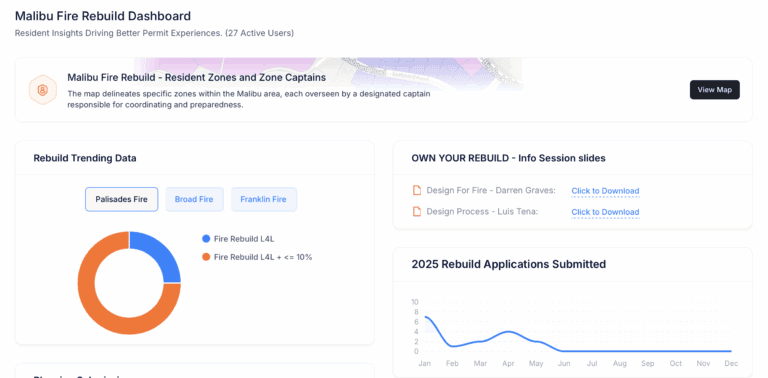
At a community-led session, experts share practical strategies, insights, and support
It’s a daunting task to rebuild your home after a wildfire, but, fortunately, there are many experts in Malibu to guide you in the right direction. The Malibu Rebuild Task Force (MRTF) held a community-led information session where experts presented an initial roadmap for those in Malibu facing the overwhelming challenge of how to begin.
Moderated by Malibu’s Abe Roy, an experienced contractor now serving as Malibu’s newly appointed rebuild ambassador, the session was presented after thoughtful brainstorming from stakeholders on a mission to rebuild the community safely and as quickly as possible.
Leading the discussion was local architect Luis Tena who presented a comprehensive 70-page slide-show road map to the rebuild process. Tena mentioned an allowance for rebuilds that comes up frequently — like for like plus 10%. Yes, rebuilds are allowed 10% more square footage; however, anything over 10% won’t receive fire rebuild treatment exemptions and will trigger a Coastal Development Permit, which takes an average four years for permitting. You have the freedom to relocate your structure as long as it doesn’t encroach into yard setbacks, steep slopes, or view corridors. After Tena’s presentation, Darren Graves presented a slide show with more technical aspects of building a fire-resilient structure. Both slide shows are available on the MRTF website.
Malibu’s John Watkins who lost his “dream home” in the Woolsey Fire offered, “Most of us here had no intention of building a home. But somehow, we found ourselves in this position.” He was able to rebuild in a remarkable 30 months. He gave some tips. “If you haven’t hired an architect yet, please do it,” he advised. “It’s the number one thing you’ve got to get going to get it going.” His second tip: “This existing plus 10%; yeah, you could have the 10%. You may not even need to go to 10%,” indicating going bigger could cause other problems like pushing you over your setbacks or getting into“tussles” with the Planning Department. Watkins’ message was to keep it simple.
“You had a house you probably loved,” he said. “If you just rebuilt what you had, well, it wouldn’t be so bad, you know? I have friends who still have not moved into a house that was burned in 2018. You know why? Because they wanted to put up something that obstructed their neighbor’s view, and now they’re fighting with their neighbor. We built pretty much what we had.”
Watkins decided to become what’s known as an “owner/builder” without hiring a general contractor who takes 20%. He hired a project manager instead. It meant he had to take on a lot of paperwork, but in the end was a money saver for his project.
And, lastly, the longtime resident offered this: “Make friends with everybody (behind the counter).” He suggested cooperating and offering solutions to the decision-makers. And he added, “Don’t sweat the small stuff! Most of us didn’tbuild a house that we were living in, right? Most of us found a house, we bought the house, we moved in. Did we look atevery handle on every single cupboard, the wallpaper, and is it a sash window, a slider, whatever? No. You bought the house, and you loved it, and it had some things you didn’t love. All of a sudden, when you start to build a house andthere’s 60 different kinds of knobs you could put on your cabinets.” Watkins used the “Hate Rule.” If one person hates something, they win according to Watkins because, “you can always live without something that you love, but it’s very hard to live with something that you hate, right? Trust me, it really works.”
Another of the many speakers was Los Angeles County Fire Marshal Richard Stillwagon, who promised his No. 1 goal is“to get everybody back in their homes.” His department received over $3 million to upgrade computer systems and hire 26 new personnel that were never funded previously. That translates into extra LACO Fire Department personnel stationed at City Hall to work on rebuilds.
Importantly, Stillwagon said the Fire Department received permission from the State to perform fuel reduction on stateand even MRCA land that abuts Malibu properties. That news was well-received by those in attendance.
Roy encouraged those affected by the wildfires to visit the MRTF website. “I lead the MRTF and the team is comprised principally of the zone captains and a handful of knowledgeable experts. The zone captains liaise with their zone residents and bring up issues that are affecting progress. I, in turn, in my capacity as the Rebuild Ambassador address and resolve them with the city heads. It’s a resource for the fire rebuilder, one that can provide significant assistance in passing info up and down as they become available and voice concerns.”
To find your zone captain, see the informative slide shows presented, and more go to malibufirerebuilds.org.